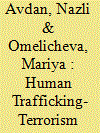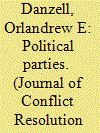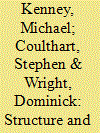|
|
|
Sort Order |
|
|
|
Items / Page
|
|
|
|
|
|
|
| Srl | Item |
| 1 |
ID:
181165


|
|
|
|
|
| Summary/Abstract |
Why do some militant organizations participate in human trafficking? We investigate this question by introducing a new dataset that records insurgent organizations’ involvement in four types of human trafficking: sexual exploitation, forced recruitment, slavery, and kidnapping. Marrying our data to the BAAD2I population of insurgent organizations, we uncover the organizational attributes related to human trafficking. We find that groups with wide alliance networks and territorial control are more likely to commit human trafficking. Organizations that are losing command of the territory and suffering rank-and-file losses are also more likely to turn to human trafficking. Our study sheds theoretical light on insurgent groups’ involvement in crime. It also contributes to the empirical scholarship on sexual violence by violent groups by studying different forms of human trafficking in both conflict and non-conflict environments. Our paper presents an original dataset and empirical analysis of insurgent groups’ human trafficking patterns.
|
|
|
|
|
|
|
|
|
|
|
|
|
|
|
|
| 2 |
ID:
101858


|
|
|
|
|
| Publication |
2011.
|
| Summary/Abstract |
The purpose of this article is to explain the creation of terrorist organizations by political parties. Extant literature argues that institutional structural constraints, such as electoral systems, are more likely to lead political parties to create terrorist organizations. However, this article hypothesizes that party ideology is also an important factor that explains the creation of terrorist organizations by political parties. Using a Poisson random effect model for panel data on twenty-eight countries between 1965 and 2003, this article shows that party ideology is positively correlated with the formation of terrorist organizations even after controlling for institutional structural constraints. The implication of these findings is important for policy makers eager to create stable polities.
|
|
|
|
|
|
|
|
|
|
|
|
|
|
|
|
| 3 |
ID:
077067


|
|
|
|
|
| Publication |
2007.
|
| Summary/Abstract |
After the events of 9/11, U.S. counterterrorism became more proactive in that the Patriot Act allowed the authorities far more freedom to directly attack terrorist network structures. We argue that rational terrorists will attempt to thwart such policies and restructure themselves to be less penetrable. We model the trade-off between security and intragroup communication faced by terrorists. The model is used to derive the anticipated changes in network structure and the consequent changes in the type, complexity, and success rate of potential terrorist attacks.
|
|
|
|
|
|
|
|
|
|
|
|
|
|
|
|
| 4 |
ID:
156540


|
|
|
|
|
| Summary/Abstract |
This study combines network science and ethnography to explore how al-Muhajiroun, a banned Islamist network, continued its high-risk activism despite being targeted for disruption by British authorities. We analyze news reports, interviews, and field notes using social network analysis and qualitative content analysis to test hypotheses pertaining to network structure and performance. Our analysis suggests that the activist network’s structural properties had important implications for its performance during three separate time periods. What began as a centralized, scale-free-like, small-world network centered on a charismatic leader evolved into a more decentralized “small-world-like” network featuring clusters of local activists connected through multiple bridges. This structure allowed the activist network to engage in contentious politics even as its environment became increasingly hostile. We conclude by discussing the implications of al-Muhajiroun’s small-world solution for scholars and policy makers.
|
|
|
|
|
|
|
|
|
|
|
|
|
|
|
|
| 5 |
ID:
085234


|
|
|
|
|
| Publication |
2008.
|
| Summary/Abstract |
The Triborder region of South America, where the borders of Argentina, Brazil and Paraguay intersect, comprises a population of approximately 700,000 inhabitants, among them 15,000-20,000 are Arabs, mostly of Lebanese descent. The region has gained a reputation as a hub of illegal activities, ranging from sales of pirated electronic goods and software to trafficking in drugs, weapons and illegal migrants. Also, the Triborder's relatively unregulated financial sector launders tens of billions of dollars of criminal funds and causes flight of capital annually. Reports that the region is a terrorist haven and staging area seem exaggerated; yet Arabs' extensive participation in the Triborder underground economy is believed to generate funds on behalf of Islamic extremists in the Middle East, especially Hezbollah and Hamas. Efforts to crack down on pirate businesses and alleged terrorist financiers have been constrained by government apathy, widespread police and judicial corruption and a lack of effective anti-terrorist legislation. Also, the dependence of many of the Triborder's inhabitants on the underground economy represents an effective constraint on enforcement action.
|
|
|
|
|
|
|
|
|
|
|
|
|
|
|
|
|
|
|
|
|